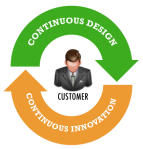I was fortunate to have been invited to the 4th annual Human Computer Interaction 2012 (HCI) conference as a chief guest, which was held in Pune in April 2012. After pondering over different topics, I decided to talk about something that I feel very passionate about which is 'Design Led Thinking - Why Now? Why in Emerging Markets?'. This blog is a synopsis of my talk at HCI and represent my thought on this topic. I would like to know what you think on this subject, so please, let the comments flow freely.
As someone has said 'Good design goes to heaven and bad design goes everywhere'. This is so true in our everyday life where we find badly designed web sites and products all around us. Following three examples are great stories (websites) of how bad a product can be designed which violates pretty much all of the wisdom out there about design principles.
- Thourough
While bad design is all around us, there are some excellent examples of good design such as TESCO HomePlus virtual subway store created in south korea (http://www.youtube.com/watch?v=fGaVFRzTTP4). This is a great story which incorporates innovation, simplest design, aesthetics, usefulness and many other characteristics of a good design. Flipkart, Samsung, Apple, Pinterest are few of the great stories where design has been numero uno differentiator for them. At the same time, Nokia and Sony has been examples where they no longer produce break through design ideas as before and hence, has been in decline for a while now. Nokia may bounce back with Lumia 900 but yet to be seen.
So, what's different you may ask especially, if the good and bad designs have been around all along? Why is design or design led thinking for creating new products is important in current market conditions? There are many reasons but I would like to stay focused on three key reasons as to why design led thinking is stealing all the attention in the world in this decade.
 US alone consumes 10,485 Trillion words. This is significantly more than what it used to be even few years ago. With the infrastructure, internet and smartphones becoming available and affordable in the developing economies like India, China and Brail, data consumption will not see decline for decades to come. The following picture nicely articulates how US alone consumes data.
US alone consumes 10,485 Trillion words. This is significantly more than what it used to be even few years ago. With the infrastructure, internet and smartphones becoming available and affordable in the developing economies like India, China and Brail, data consumption will not see decline for decades to come. The following picture nicely articulates how US alone consumes data.
The result of lower attention span and yet, data consumption only going upward means that there is need more than ever to create an impact via highly innovative product or website designs.
 primary charter for CMO. 1) Empowered customers are NOW in control of business relationships 2) Delivering customer VALUE is paramount and 3) The pressure to be accountable requires new approaches, tools and skills. CIOs and CMOs are now equally being held responsible for revenues and profitability of the products / company. Also, given the consumer driven market, customers are in total control to decide fate of any product and all of the social networking has made that even more easier. Result of these factors is that CIOs and CMOs want to quickly take ideas to market as a beta product, experiment with various ideas / designs and incrementally build the product to avoid failures late in the cycle. To achieve such an objective, one would need to adopt and embark on 'Continuous Design - Continuous Innovation' journey.
primary charter for CMO. 1) Empowered customers are NOW in control of business relationships 2) Delivering customer VALUE is paramount and 3) The pressure to be accountable requires new approaches, tools and skills. CIOs and CMOs are now equally being held responsible for revenues and profitability of the products / company. Also, given the consumer driven market, customers are in total control to decide fate of any product and all of the social networking has made that even more easier. Result of these factors is that CIOs and CMOs want to quickly take ideas to market as a beta product, experiment with various ideas / designs and incrementally build the product to avoid failures late in the cycle. To achieve such an objective, one would need to adopt and embark on 'Continuous Design - Continuous Innovation' journey.
For what its worth, design has hit prime time in Silicon Valley and as per one study, the valuation formulae for talent acquisition is:
- $1MM per developer
- $500K per MBA and
- $2MM per designer
If you put all of these together - there is certainly a strong case for 'Why Now' as far as design led thinking goes. What do you think? What has been your experience? Do you have stories to share? If so, please go on - comment.



